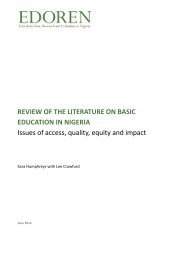review-of-the-literature-on-basic-education-in-nigeria-june-2014-3-1
review-of-the-literature-on-basic-education-in-nigeria-june-2014-3-1
review-of-the-literature-on-basic-education-in-nigeria-june-2014-3-1
Create successful ePaper yourself
Turn your PDF publications into a flip-book with our unique Google optimized e-Paper software.
Review <str<strong>on</strong>g>of</str<strong>on</strong>g> <str<strong>on</strong>g>the</str<strong>on</strong>g> <str<strong>on</strong>g>literature</str<strong>on</strong>g> <strong>on</strong> <strong>basic</strong> educati<strong>on</strong> <strong>in</strong> Nigeria3.3 School <strong>in</strong>frastructureThe state <str<strong>on</strong>g>of</str<strong>on</strong>g> school <strong>in</strong>frastructure has been shown to have a major impact <strong>on</strong> perceived and actualeducati<strong>on</strong>al quality and <strong>on</strong> susta<strong>in</strong>ed pupil access <strong>in</strong> Nigeria (UBEC 2012a; NPC and RTI Internati<strong>on</strong>al2011), as well as <strong>on</strong> teacher motivati<strong>on</strong> (Sherry 2008; Takahashi 2010; UBEC 2012a; Dunne et al. 2013).Despite large amounts <str<strong>on</strong>g>of</str<strong>on</strong>g> m<strong>on</strong>ey be<strong>in</strong>g allocated to UBE, studies have c<strong>on</strong>sistently commented <strong>on</strong> <str<strong>on</strong>g>the</str<strong>on</strong>g>poor state <str<strong>on</strong>g>of</str<strong>on</strong>g> repair <str<strong>on</strong>g>of</str<strong>on</strong>g> many Nigerian public primary schools (e.g. Urwick and Aliyu 2003; FME 2005;Hardman et al. 2008; Holfeld et al. 2008; Ikoya 2008; Ikoya and Onoyase 2008; Sherry, 2008; Boult<strong>on</strong> etal. 2009; Copp<strong>in</strong>ger 2009; USAID 2009; Okojie 2012; UBEC 2012a; Dunne et al. 2013), which FGN readilyacknowledges (FME 2009a). In <str<strong>on</strong>g>the</str<strong>on</strong>g> 2010 NEDS, over 40% <str<strong>on</strong>g>of</str<strong>on</strong>g> resp<strong>on</strong>dents perceived that <str<strong>on</strong>g>the</str<strong>on</strong>g>re wereproblems with primary school build<strong>in</strong>gs and facilities, as well as classroom overcrowd<strong>in</strong>g. Regi<strong>on</strong>alvariati<strong>on</strong> was substantial, with figures <str<strong>on</strong>g>of</str<strong>on</strong>g> well over 60% for <str<strong>on</strong>g>the</str<strong>on</strong>g> North East and North West and higherfigures too for poorer households. The difference between government and private schools was alsoc<strong>on</strong>siderable, with parents/guardians <str<strong>on</strong>g>of</str<strong>on</strong>g> children <strong>in</strong> government schools around four times more likelyto c<strong>on</strong>sider <str<strong>on</strong>g>the</str<strong>on</strong>g> school to have ‘big problems’ with <strong>in</strong>frastructure, and around five times more likely toc<strong>on</strong>sider overcrowd<strong>in</strong>g to be a ‘big problem’ than parents/guardians <str<strong>on</strong>g>of</str<strong>on</strong>g> children <strong>in</strong> private schools (NPCand RTI Internati<strong>on</strong>al 2011).The most comprehensive nati<strong>on</strong>al survey <str<strong>on</strong>g>of</str<strong>on</strong>g> primary school <strong>in</strong>frastructure was carried out by Ikoya andOnoyase (2008) us<strong>in</strong>g exist<strong>in</strong>g survey and household data from five LGAs <strong>in</strong> each <str<strong>on</strong>g>of</str<strong>on</strong>g> two sample statesfrom each <str<strong>on</strong>g>of</str<strong>on</strong>g> <str<strong>on</strong>g>the</str<strong>on</strong>g> geo-political z<strong>on</strong>es and <str<strong>on</strong>g>the</str<strong>on</strong>g> FCT. They also c<strong>on</strong>cluded that <strong>in</strong>frastructure was <strong>in</strong> a badstate. Specifically:53% <str<strong>on</strong>g>of</str<strong>on</strong>g> schools lacked fundamental structures;Only 20% had sufficient <strong>in</strong>frastructure <strong>in</strong> terms <str<strong>on</strong>g>of</str<strong>on</strong>g> quantity and quality and 92% <str<strong>on</strong>g>of</str<strong>on</strong>g> <str<strong>on</strong>g>the</str<strong>on</strong>g>m were notregular public schools attended by <str<strong>on</strong>g>the</str<strong>on</strong>g> majority <str<strong>on</strong>g>of</str<strong>on</strong>g> children but ra<str<strong>on</strong>g>the</str<strong>on</strong>g>r model or unity schools; 14Over 68% had no functi<strong>on</strong><strong>in</strong>g library; and65% had no electricity, 54% had no pipe-borne water, and 78% had no school transport.However, it is not clear whe<str<strong>on</strong>g>the</str<strong>on</strong>g>r <strong>on</strong>ly public schools were c<strong>on</strong>sidered <strong>in</strong> <str<strong>on</strong>g>the</str<strong>on</strong>g> study; nor was <str<strong>on</strong>g>the</str<strong>on</strong>g> z<strong>on</strong>albreakdown <str<strong>on</strong>g>of</str<strong>on</strong>g> <strong>in</strong>frastructural facilities presented.An ESSPIN assessment <str<strong>on</strong>g>of</str<strong>on</strong>g> <strong>basic</strong> educati<strong>on</strong> facilities <strong>in</strong> Kano, Jigawa and Kaduna states c<strong>on</strong>cluded thataround 75% <str<strong>on</strong>g>of</str<strong>on</strong>g> school <strong>in</strong>frastructure was ‘very poor’ (Copp<strong>in</strong>ger 2009), while <str<strong>on</strong>g>the</str<strong>on</strong>g> 2009/10 school census<strong>in</strong> Adamawa State deemed 67% <str<strong>on</strong>g>of</str<strong>on</strong>g> public primary school classrooms to be <strong>in</strong> ‘poor c<strong>on</strong>diti<strong>on</strong>’ (Dunne etal. 2013).More recently <strong>in</strong> many d<strong>on</strong>or-supported states, primarily <strong>in</strong> nor<str<strong>on</strong>g>the</str<strong>on</strong>g>rn Nigeria, substantial <strong>in</strong>frastructuraldevelopment has been reported, both state and d<strong>on</strong>or-sp<strong>on</strong>sored. Table 3.2, tak<strong>in</strong>g figures from <str<strong>on</strong>g>the</str<strong>on</strong>g>relevant 2011/12 ASC reports, shows <str<strong>on</strong>g>the</str<strong>on</strong>g> current situati<strong>on</strong> <strong>in</strong> Kano, Jigawa and Kaduna states <strong>in</strong> <str<strong>on</strong>g>the</str<strong>on</strong>g>North West and also <strong>in</strong> Lagos State. The figures illustrate both <str<strong>on</strong>g>the</str<strong>on</strong>g> c<strong>on</strong>t<strong>in</strong>ued need to improve school<strong>in</strong>frastructure and <str<strong>on</strong>g>the</str<strong>on</strong>g> variati<strong>on</strong> <strong>in</strong> <strong>in</strong>frastructural provisi<strong>on</strong> between states. Lagos State fares bestoverall at primary level, but is <str<strong>on</strong>g>the</str<strong>on</strong>g> worst <str<strong>on</strong>g>of</str<strong>on</strong>g> <str<strong>on</strong>g>the</str<strong>on</strong>g> four states at JSS level, as shown <strong>in</strong> Table 3.3. With <str<strong>on</strong>g>the</str<strong>on</strong>g>excepti<strong>on</strong> <str<strong>on</strong>g>of</str<strong>on</strong>g> Lagos State, a comparis<strong>on</strong> <str<strong>on</strong>g>of</str<strong>on</strong>g> tables 3.2 and 3.3 suggests that <strong>on</strong> average <str<strong>on</strong>g>the</str<strong>on</strong>g> provisi<strong>on</strong> <str<strong>on</strong>g>of</str<strong>on</strong>g>school <strong>in</strong>frastructure is slightly better at JSS than at primary school level. Perhaps even more significantis <str<strong>on</strong>g>the</str<strong>on</strong>g> huge range <strong>in</strong> <strong>in</strong>frastructural quality across <str<strong>on</strong>g>the</str<strong>on</strong>g> LGEAs with<strong>in</strong> each state. Thus, for example, asshown <strong>in</strong> Table 3.2, <strong>on</strong>e LGEA <strong>in</strong> Kano State has 16% <str<strong>on</strong>g>of</str<strong>on</strong>g> primary classrooms without a good chalkboard,whereas ano<str<strong>on</strong>g>the</str<strong>on</strong>g>r LGEA has 93% <str<strong>on</strong>g>of</str<strong>on</strong>g> classrooms without <strong>on</strong>e.14‘Unity schools’, formally known as federal government colleges, were <strong>in</strong>stituted <strong>in</strong> <str<strong>on</strong>g>the</str<strong>on</strong>g> 1970s, follow<strong>in</strong>g <str<strong>on</strong>g>the</str<strong>on</strong>g> civil war, <strong>in</strong> anattempt to foster nati<strong>on</strong>al unity; <str<strong>on</strong>g>the</str<strong>on</strong>g>y aimed to br<strong>in</strong>g toge<str<strong>on</strong>g>the</str<strong>on</strong>g>r <str<strong>on</strong>g>the</str<strong>on</strong>g> best students from around <str<strong>on</strong>g>the</str<strong>on</strong>g> country irrespective <str<strong>on</strong>g>of</str<strong>on</strong>g>ethnicity, religi<strong>on</strong> or locati<strong>on</strong>. There are currently two <strong>in</strong> each state. ‘Model schools’ are also generally better resourced than<str<strong>on</strong>g>the</str<strong>on</strong>g> average school.EDOREN – Educati<strong>on</strong> Data, Research and Evaluati<strong>on</strong> <strong>in</strong> Nigeria 26



